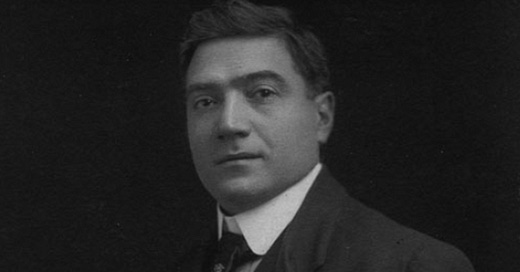Alviene was in the audience to see how his young students were doing and offered encouragement and suggestions. He appears to have suggested that they be enrolled for lessons in the ballet school of the Metropolitan Opera and helped secure future bookings, including Young’s Pier Theatre in Atlantic City (Riley 51). Did they take further ballet lessons? Possibly. An article in the New York Times after they had opened in Apple Blossoms for their first starring role on Broadway reported that they were placed under the “metropolitan ballet master Tier for a time,” but there is no mention of Alviene (Who's Who on the Stage: Fred and Adele Astaire). Nearly 70 years later, in an interview Astaire said “the only ballet that I ever learned was from a man named Albertieri, who is also mentioned in this book of mine—I have no idea what else he was, but he was a ballet teacher” (Saltus 10)[i].
Luigi Albertieri was a ballet dancer, choreographer and teacher, who worked periodically at the Metropolitan Opera in 1894-95, 1902-3 and 1904-6 (Dorris 199). After emigrating permanently to the United States in 1910, he served as ballet master for the Chicago Lyric Opera (1910-13), New York’s Century Opera (1914) and the Metropolitan Opera (1913-27) (Cohen-Stratyner 10). In 1915, he opened an independent studio at 11 E. 59th St., where he taught a broad range of styles beyond ballet, including folk, toe, character and modern dancing. His studio advertised special training for children and dancing teachers. He also coached pupils for dramatic, operatic, vaudeville and musical comedy productions (Albertieri Moves Studio). In 1923 he published a ballet textbook, The Art of Terpsichore, and he continued to lead the Albertieri Studio until his death in 1930. Albertieri is credited as ballet master or choreographer for five different Broadway productions: The Ladies Paradise (1901), Miss Simplicity (1902), The Top o’ th’ World (1907-8), The Firefly (1912-13) and Chin Chin (1914), which was produced by Charles Dillingham. It’s possible that Albertieri may have worked with Aurelio Coccia, who would also later be an Astaire teacher. A brief newspaper article in 1900 announced that the vaudeville program for Ted Marks’ Summer Soirees on the Casino Roof, would close with a ballet “with choruses by Albertieri and Coccia, entitled ‘Naples and the Open Door’” (Heard Down the Line). They reconnected nine years later to form a partnership to produce vaudeville and burlesque pantomimes (Luigi Albertier and Coccia Form Partnership).
Among Albertieri’s pupils over the years were dancers Margaret Severn, who would appear on stage with the Astaires in 1921 at the May 1 benefit for Actors Equity Association at the Metropolitan Opera House, Maria Gambarelli, who would appear with Astaire at the Dancers Club benefit on December 11, 1932, and Albertina Rasch, who would work even more deeply with the Astaires. Severn, who studied with Albertieri starting in 1914, described him as having a fiery temper, intolerant of any method not his own, while showing consummate artistry (Severn 259). He would play the fiddle while his pupils danced and would also wield a large stick to thump the rhythm on the floor or strike an offending knee or instep (Severn 260). Astaire vividly recalls Alviene beating time with a stick on the back of a chair during their lessons (Astaire 17). Phyllis Marmein, another of Albertieri’s pupils, remembered him wearing ordinary trousers and a pajama coat while smoking cigars that would choke her if she danced too close during the two-hour lessons that focused on old-school, romantic ballet training (Tap Dancing Class Wins Approval of Commission 8).

Albertieri would certainly have been in Manhattan at the end of 1905, as he was in the midst of his work at the Metropolitan Opera for the 1904-5 and 1905-6 seasons, and as his later career indicates he would be an instructor and coach for stage performers, including children. The classes would have been held at the Metropolitan Opera, which was built in 1883 at 1411 Broadway on the west side of Broadway between 39th and 40th streets. On August 27, 1892, the building was gutted by fire, causing the 1892-93 season to be canceled. After being quickly rebuilt along its original lines, the Metropolitan was extensively redesigned in 1903 by architects Carrere and Hastings.

SOURCES
"Albertieri Moves Studio." New York Dramatic Mirro 8 September 1915: 10.
Astaire, Fred. Steps in Time. New York: Harper & Brothers, 1959.
Cohen-Stratyner, Barbara Naomi. Biographical Dictionary of Dance. New York: Schrimer Books, 1982.
Dorris, George. "Dance and the New York Opera War, 1906-1912." Dance Chronicle 32.2 (2009): 195-262.
"Heard Down the Line." New York Sunday Telegraph 3 June 1900: 2.
"Luigi Albertier and Coccia Form Partnership." New York Clipper 31 July 1909: 642.
Saltus, Carol. "Fred Astaire." Andy Warhol's Interview June 1973: 9-16.
Riley, Kathleen. The Astaires: Fred & Adele. New York: Oxford University Press, 2012.
Severn, Margaret. "Scenes from a Dancer's Life, Part One: 1910-1919." Dance Chronicle 15.3 (1992): 253-290.
"Tap Dancing Class Wins Approval of Commission." Citizen Sentinel (Ossining, NY) 9 March 1932: 8.
"Who's Who on the Stage: Fred and Adele Astaire." New York Times 16 November 1919: XX:3.
Zeller, Jessica. “Luigi Albertieri: Bringing Italian Traditions to American Ballet.” Dance Chronicle, 38:1, 55-80. https://doi.org/10.1080/01472526.2015.999306
[i]Astaire does not mention Albertieri in the published version of his autobiography, where he mentions only Alviene, Ned Wayburn, and Aurelia Coccia as his teachers.



